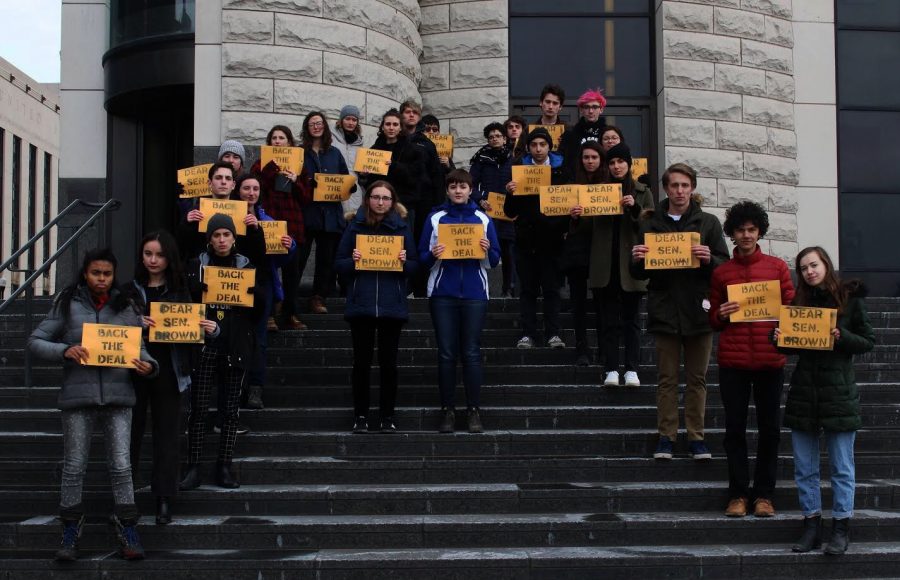We Can — And Must — Implement Green New Deal
Student members of Oberlin’s new chapter of the Sunrise Movement gather at Senator Sherrod Brown’s office to demand he support the Green New Deal.
Days after Democrats won a majority in the House of Representatives in last year’s midterm elections, 150 young activists from the environmental activist group Sunrise Movement staged a massive sit-in at Speaker Nancy Pelosi’s office. Their demand? That the new Democratic majority produce a bold, comprehensive plan to address climate change. The United Nations’ climate report from a month earlier issued a stark warning: drastically reduce carbon emissions by 2030 or face an irreversible climate catastrophe. After decades of inaction and missed opportunities, the U.N.’s Intergovernmental Panel on Climate Change report confirmed that our next chance will be our last to enact transformative climate legislation.
As the demonstrators prepared for arrest, Rep. Alexandria Ocasio-Cortez squeezed past the wall of reporters and gave an impassioned speech, proclaiming her support for the protesters and vowing to fight with them for a Green New Deal. The Sunrisers watched in awe, realizing they had finally elected one of their own. This electric encounter sent shockwaves through Washington, and after decades of stagnation, instantly transformed the political realities of climate change.
The Green New Deal is a policy framework designed to address the dual crises of environmental destruction and economic inequality. It currently exists in the form of a 14-page Congressional resolution — essentially a mission statement that lays out major goals and projects, which various think tanks and policy experts will fill in with details. The resolution’s five goals include achieving net-zero greenhouse gas emissions; creating millions of high-wage jobs; investing in infrastructure to sustainably meet the challenges of the 21st century; securing clean air and water for all; and promoting justice and equity by addressing historic, current, and future oppression of vulnerable communities on the frontlines of climate change and economic inequality.
To achieve these goals, the Green New Deal calls for World War II-style economic mobilization, with the federal government leading the way by investing in green energy infrastructure, mass transit, energy efficiency, and reforestation. Rather than downplay the daunting scale of this project, the Green New Deal leans into the economic potential of such a transition, promising to leave no one behind. A federal jobs guarantee is central to the proposal, as are racial justice and Indigenous sovereignty. This is a sharp departure from the market-based, deficit-neutral, colorblind climate policies of the past.
The shift is jarring for some. Confronted by young Sunrise activists last week, Sen. Dianne Feinstein dismissed the proposal as too expensive and not politically feasible. This argument is hard to take seriously, if only because the cost of the Green New Deal pales in comparison to that of environmental destruction. The IPCC report demands, “rapid, far-reaching and unprecedented changes in all aspects of society.” This is what the Green New Deal offers. Those concerned about fiscal responsibility should release their plan to pay for the devastating economic impacts of climate change, which will shrink our economy by 10 percent this century according to the U.S.’s National Climate Assessment.
Feinstein’s view also ignores the recent history of climate politics. In 2009, the American Clean Energy and Security Act — which sought to establish a nationwide cap-and-trade system to curb greenhouse gas emissions — died in the Democrat-controlled Senate. Already staring down the gauntlet of healthcare reform, several moderate Democrats abandoned the effort amid a barrage of right-wing attacks. This was an important lesson for environmental activists — any serious climate policy is a threat to the fossil fuel industry and will incur the wrath of Republicans, even a relatively conservative program like cap-and-trade. The question is not whether a bill can appease opposition, but how much support it can build, and how effectively that base of support can hold Democrats accountable. No one was marching in the streets for cap-and-trade because people don’t mobilize for half-measures; the grassroots enthusiasm for the Green New Deal has shown that real solutions find real support. The Green New Deal’s economic and social commitments are not liabilities, but crucial for building the broad, diverse, energized coalition necessary to take on the fossil fuel empire.
For all its naysayers, the Green New Deal has gained enormous popular support — 80 percent of registered voters support a Green Jobs Guarantee according to a recent poll from Yale University. The Congressional resolution has racked up 100 co-sponsors, including virtually every Democratic presidential candidate. This week, about 30 members of Sunrise Oberlin — a local chapter of the national movement — drove to Sen. Sherrod Brown’s office and demanded that he sign on as well. Across the country, hundreds of similar Sunrise groups are materializing, each representing scores of young people ready to rally their communities behind the Green New Deal. And, for the first time in our lives, we have representatives in Washington who are fighting for environmental justice.
A solution is finally on the table. Is it unrealistic? Some may think so, but it is necessary for human survival. If the Green New Deal is politically impossible, our job is to organize, mobilize, and build the people power necessary to make it possible







